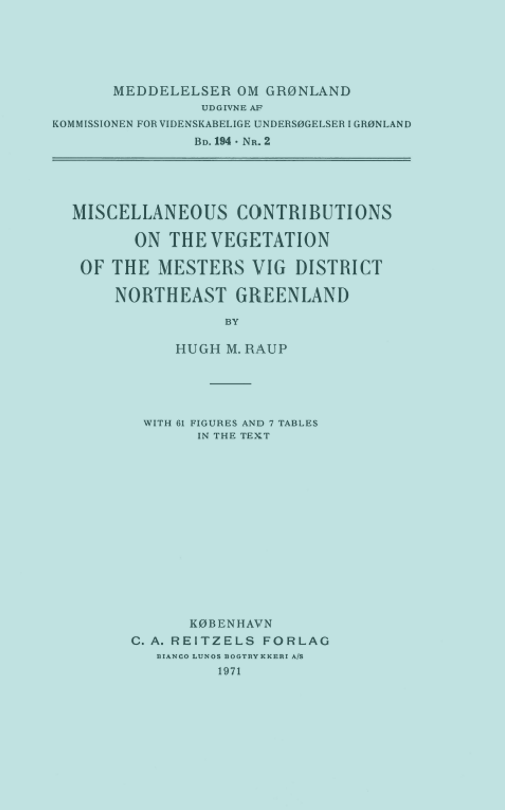Miscellaneous Contributions on the Vegetation of the Mesters Vig District, Northeast Greenland.
DOI:
https://doi.org/10.7146/mog.v194.149345Abstract
The first paper in this series deals with the vegetation of kames and emerged delta remnants that cover a large area about the mouth of Tunnelelv, reaching altitudes of about 110 m on the lower mountain slopes. Following a general discussion of the site factors of ground coverage by vascular plants, moisture, and physical disturbance, the vegetation is described in two specific localities. One of these involves the evolution of turf hummock systems in a small valley, and the other emphasizes the effects of wind deflation and deposition. Finally the flora of the kames and delta remnants is analyzed in terms of its tolerance of variation on the factor gradients mentioned above. An appendix contains observations on the effects of wind in two localities on the shore of the
fjord.
The second paper describes the vegetation of a large earthflow in the hills back of Nyhavn. This flow exhibited a fresh break-away scarp and a disturbed area of accumulation below it resulting from an episode that appeared to have occurred within the preceding two years. Comparison was made with scars of earlier flows in the immediate vicinity. The behavior of the small vascular flora of the site ( 17 spp.) on gradients of coverage, moisture, and physical disturbance is discussed briefly, with no attempt to analyze it in detail.
The effects of slushflow upon vegetation are discussed in the third paper, which is based primarily upon observations in two localities: in the lower valley of a small mountain stream called Lejrelv, and in a similar situation at an altitude of about 230 m on the lower northeast slope of Hesteskoen. Slushflows in both of these areas occurred in the spring of 1958, and in both places botanical observations were made before and after the episodes. The flora is analyzed for differences in species compositions and in the tolerance proportions among its species 1 ½ months, 2 years, and 6 years after the 1958 flows. An attempt is made to date earlier flows by the ages and times of physical injury shown by specimens of Salix arctica and Betula nana collected from the Lejrelv gully and its adjacent slushflow fan. It is suggested tentatively that the flows have occurred approximately at 10-year intervals since about 1900.
The fourth paper is devoted to palsen-like structures found in 1964 in the Tunnelelv valley about 2 km northeast of the base of Gorms Spids. They are in an area of well-developed turf hummocks, and appear as large peat mounds up to 10 x 8 m in ground plan and 1 ½ m high. Some have their upper surfaces covered with turf hummocks of living moss and vascular plants, while on others the moss is dead and dry, causing the surface to be shrunken to saucer form. Several species of more xerophytic plants, not characteristic of the neighboring turf hummocks, are found on these dried surfaces. It is proposed that the large mounds are formed by intense frost action in the soils beneath, which are saturated throughout the summer. However, no excavations for evidence of this were made.
The fifth paper discusses the vascular plants of lake and sea shores in the Mesters Vig district. Both of these are poorly developed in the district, some small ponds and lakes and many sea shores being completely sterile. Information is reported from about 12 ponds and lakes and from several sea shores ranging from boulder beaches to sand and mud flats. It is suggested that the scarcity of the flora is due to the shortness and uncertainty of the available growing season and, in some lakes, to major fluctuations in water levels.
Calcicoly among Mesters Vig vascular plants, discussed in the sixth paper, is considered to be of minor importance due to limited development of habitats conducive to it. Basic elements in the soil are present very locally, due to occasional limestone pebbles, cobbles or boulders in the till and outwash, or to shells in the marine silts and clayey silts near the shore of the fjord. Comparison is made between the flora of the Mesters Vig district and reportedly calcicolous floras in neighboring parts of the fjord region.
The seventh paper deals with the vegetation of artificially disturbed habitats. It rests primarily on observations in the neighborhood of the Mesters Vig airfield and at "Camp Tahoe" which was the base for the expedition; but it also includes miscellaneous data from many other localities. No introduced plants were seen in the district, but 44 species from the native flora were found in ruderal habitats. Most of those found are from the vegetation types that were affected by the man-made disturbances, and it is suggested that more ruderal species would appear if other types were disturbed. The ruderal flora is analyzed in terms of its tolerance ratings on gradients of coverage, moisture and physical disturbance. The results suggest that the ruderal species are selected from their respective vegetation types by their special tolerances of nonfrost disturbance. It is impossible with present data to separate in some cases the effects of fertilization from those of physical disturbance. Other cases suggest that ruderal habitats are provided primarily by physical disturbance.

Downloads
Published
How to Cite
Issue
Section
License
Coypyright by the authors and the Commision for Scientific Research in Greenland. No parts of the publications may be reproduced in any form without the written permission by the copyright owners.

